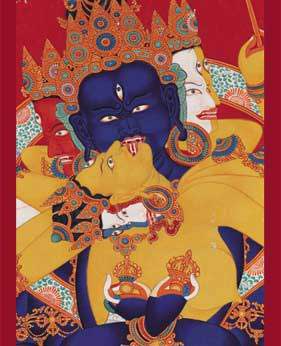Source: tibet.cn
09-05-2007 20:41
 |
Tangka of Kalachakra.kalachara namely the Well of Time
Tangka is a kind of scroll painting mounted on silk. It has distinctive ethnic features and a strong religious flavor. Its unique artistic style is highly prized by the Tibetan people.
The origin of tangka can be traced back to the early Tubo Kingdom. During the 7th century, King Songtsan Gambo united Tibet. To strengthen political, economic and cultural exchanges with Tibet's neighbors, he married Princess Chizun of Nepal and Princess Wencheng of the Tang Dynasty. Around this period he ordered the construction of Potala Palace and some other grand edifices. To decorate them, he drafted a large number of people to paint murals. This greatly promoted Tibet's art of painting. According to the Catalogue of Jokhang Monastery written by the Fifth Dalai Lama, "The King (Songtsan Gambo) used the blood from his nose to paint a portrait of the White Lhamo. Later, while a statue of the White Lhamo was being sculpted, the portrait was hidden in the abdomen of the statue." This is the earliest record of a tangka painting. This tangka has been lost, but we can conclude that tangka was a new Tibetan art form which flourished during the reign of Songtsan Gambo.
Following the spread of Buddhism, Buddhist art also flourished. Since tangkas are easy to make, not limited by the variety of buildings, and easy to hang and store, they were used as a means to spread Buddhism. From then on, tangkas and murals developed side by side, becoming two bright pearls in the history of Tibetan painting.
Tangkas depict a wide range of themes. A considerable number of ancient tangkas have been preserved. However, few tangkas dating from the Tang and Song dynasties remain. The Sakya Monastery houses a tangka entitled Sanggyai Dongsha, which contains 35 Buddhist images. Its style is similar to the murals found in the Dunhuang Grottoes. It is said to have been completed during the Tubo Kingdom, and is a rare treasure. The Potala Palace houses three Song Dynasty tangkas, two of which are kesi (a type of weaving done in fine silks and gold thread by the tapestry method). A portrait of Palma Toinyoi Chuba has a caption written in Tibetan at the bottom of the tangka saying that it was made at the order of Gyaincain Zhading as a gift for his teacher Chagba Gyaincain. A tangka with a portrait of Kungtang Lama (1123-1194) was made in the late Song Dynasty. Another tangka, depicting the life of Mila Rigba, describes Mila Rigba's self-cultivation. Experts have concluded that it was made in the Tang Dynasty.
In the Ming and Qing dynasties, to strengthen its rule over Tibet, the central government conferred honorific titles on religious leaders in Tibet. In the Ming Dynasty eight religious leaders received the title of prince, and in the Qing Dynasty the titles of Dalai Lama and Panchen Lama were conferred. These measures were favorable to Tibet's social order, and social and cultural development. In this period, the art of tangka also scaled a new height. The number of tangkas saw a remarkable increase, and different schools emerged. In general, the tangkas of Eestern Tibet are noted for fine brushwork, expertly depicting the inner world of man; the tangkas of Western Tibet are similar to gongbi (traditional Chinese realistic painting characterized by fine brushwork and close attention to detail) paintings with their bright colors.
